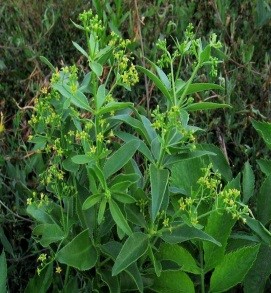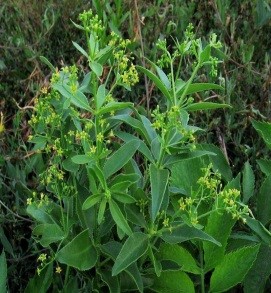Area
Royan's homeland is the Mediterranean countries. Occurs in Ukraine, Moldova, the southern, southeastern part of the European part of Russia, the Caucasus (Azerbaijan, Georgia, Armenia, Dagestan) and Central Asia. It grows mainly along streams, among bushes, along canals, in fields and gardens. Royan is grown on plantations. The products are mainly produced in Dagestan, northeastern Azerbaijan and Chechnya-Ingushetia.
Botanical description of the plant
Rubia tinctorum L. and Georgian Rubia iberica C. Koch. (Rubia tintorum L. var. Iberica Fisch. Ex DC) belongs to the family Rubicaeae.
Royan species is a perennial herb, up to 30-150 cm in height. The rhizome is long, creeping, branched, cylindrical, thick, articulated, many-headed. The stem is covered with several, four-sided, articulated, branched, and looped coarse hairs. The leaves are lanceolate-ovoid, glossy, the thick veins on the underside are covered with loose coarse hairs, with a very short band, 4-6 balls at the base. The flowers are small, greenish-yellow, clustered in a semi-umbrella that grows from the leaf axils, forming a rosette-like inflorescence. Inflorescence indistinct, corolla 5, fused, funnel-shaped, paternal 5, maternal node 2-lobed, located below. Fruit 1-2 seeds, globose, first red, then black, juicy wet fruit. It blooms in June-August, the fruits ripen in August-September.

Medicinal properties
Rhubarb has antispasmodic and diuretic effects and softens kidney stones (phosphates). Therefore, its drugs are used in diseases of the urinary tract stones, kidney stones and gallstones and gout. Medicinal products. Root powder (powder), dry extract (released in tablet form). Rhizome extract is part of cystenal and other drugs used in the above diseases.
Growing technology
The fields are plowed to a depth of 27-30 cm, giving 15-20 tons of organic fertilizers and superphosphate per hectare of land before plowing in early autumn. It is advisable to apply 20 kg of nitrogen and potassium fertilizers per hectare, along with plowing the soil in automorphic soils with low crop yields.
It is also propagated by seeds and rhizomes. It is also possible not to stratify the seeds before sowing. The lands plowed in early spring are plowed, mulched and cultivated. In mid-March, when the soil temperature is 10–12 ° C, 13–15 kg of seeds per hectare is consumed. Its planting depth should not be less than 4–5 cm. Seed germination should not be less than 75-80%. When the soil temperature is moderate and the humidity is sufficient, sown seeds germinate in 10–12 days. If the rhizome is propagated from cuttings, its germination rate should not be less than 80–90%. Rhizomes should be planted at a depth of 8–10 cm in early spring. An average of 10-12 quintals of rhizomes are spent per hectare. Plant density is 10-15 pieces per 1 meter. If the row spacing of seeds and cuttings is planted at a distance of 60 cm, the plant will develop roots in the second and subsequent years, creating conditions for complete coverage of the soil surface. Royan plant is watered 7-8 times in the first year, the number of waterings is reduced in subsequent years. In the first year the plant spaces are softened, cleared of weeds. The first fertilization is carried out in May and June with the application of 30 kg of nitrogen and 20 kg of potassium fertilizer per hectare. The second feeding is completed in August with the application of 30 kg of nitrogen and 20 kg of superphosphate fertilizer. Plant feeding is carried out before watering. In the second and third years of the ryegrass, the first fruits are harvested without allowing them to weave when they enter the ring. Roots and rhizomes 30–35 cm from the ground with a plug in late autumn or early spring.
The inverted soil is cleaned, washed in water and dried in a dryer at 45–50 ° C. Seeds are harvested manually in two mechanisms. An average of 80-100 kg of seeds and 13-14 quintals of dry roots can be harvested from each hectare of land.





